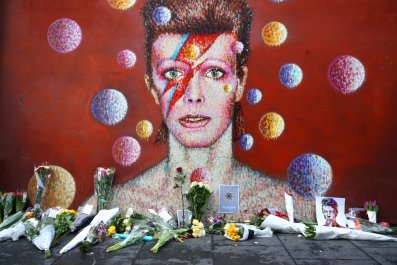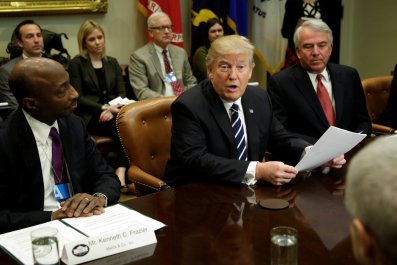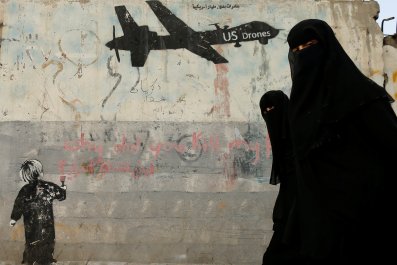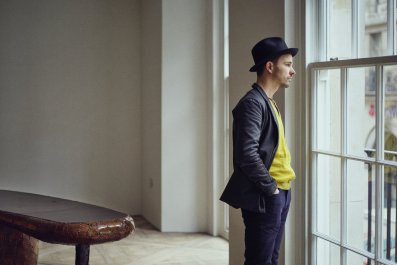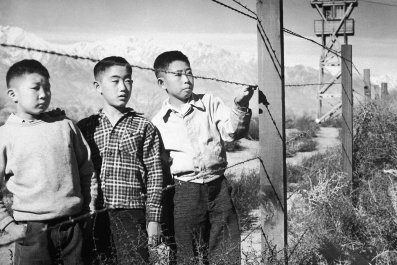It was the first black bloc for Neil Lawrence, a third-year undergraduate student at the University of California, Berkeley. He had demonstrated with Black Lives Matter and seen people in bandannas show up at events and smash things. But after the Berkeley College Republicans announced controversial Breitbart News editor Milo Yiannopoulos would be speaking on campus, Lawrence decided it was time for a more aggressive form of protest. "It became clear to me and my close friends that the tone of living in America is changing, and in order to stop being scared, we started organizing," he says. "I, a transgender Jew, don't have a problem with violence against fascists."
Through a friend who was involved in the local Antifa (anti-fascist) group, Lawrence learned activists were planning a black bloc. As a 5-feet-2-inch person who has never been in a fight, he says he wanted the safety that comes from being part of an anonymous mob. On February 1, hours before Yiannopoulos was about to speak, Lawrence and around 150 others gathered off campus where Antifa told them to meet. They got their gear and outfits ready. He was dressed in all black and had a T-shirt wrapped around his face, leaving a slit for his eyes. A person with a megaphone told the group the route they'd be marching, and they set off toward campus. Along the way, they chanted, "No borders, no nations, fuck deportation." Lawrence didn't carry anything, but others had flags and projectiles.
Berkeley students had spent weeks planning a nonviolent protest. They gathered outside the venue where Yiannopoulos would be speaking, waving signs and calling for the event to be shut down. And then the black bloc showed up. They clashed with the police and Yiannopoulos supporters. They set fires, threw Molotov cocktails and smashed windows. One of them pepper-sprayed a woman as a reporter interviewed her. Off campus, they vandalized shops and halted traffic. At around 9 p.m., the university canceled the event, but the demonstrations continued for several hours, until those dressed in black slipped into the night. Campus police made just one arrest.
The demonstrators caused an estimated $100,000 in damage on campus, the university said, and an additional $400,000 to $500,000 elsewhere, according to Downtown Berkeley Association CEO John Caner. The school has tried to distance student activists from these more aggressive ones, describing the latter in a statement as "agitators who invaded the campus and disrupted nearly 1,500 peaceful protesters." Others have said students were among the masked ones. President Donald Trump called the demonstrators "professional anarchists, thugs and paid protesters" and implied that the university should lose federal funding.

What people on both sides of this argument need to understand is that black bloc isn't a group; it's just a tactic. Those who do it wear black, sometimes between layers of "civilian" clothes so they can slip in and out of their protester ensembles. They often carry gear that is defensive (masks to protect against tear gas), offensive (Molotov cocktails) or both (a placard that can double as a shield). They attack storefronts and clash with police in a "hit and run" style, University of San Francisco associate professor Jeffrey Paris has written. There is no formal network of people and no set principles, just a belief that demonstrating peacefully doesn't accomplish nearly as much as a flash of rage. A 2008 guide published online by CrimethInc., a network for anonymous collective action, says, "Don't get caught! Stay safe(r) and smash the state!" A black bloc "communiqué" from 1999 says, "A storefront window becomes a vent to let some fresh air into the oppressive atmosphere of a retail outlet…. A building facade becomes a message board to record brainstorm ideas for a better world."
The German press coined the term black bloc in the 1980s, when activists in that country demonstrated for squatters' rights and other causes. In 1987, The New York Times described a German black bloc as "a radical and embittered fringe" that burned cars, smashed windows and hurled bottles and firecrackers. Activists went on to use the strategy in Canada, Brazil, the United Kingdom, Italy, Switzerland and, during the Arab Spring, Egypt. In the early 1990s, it appeared in the United States during protests against the Gulf War, and in 1999 it gained traction during a World Trade Organization conference in Seattle, when activists used sledgehammers, eggs filled with glass-etching solution and other equipment.
The people who use black blocs are generally affiliated with anarchist or anti-fascist movements, whose members often overlap, despite some ideological differences. One activist has said that this country's anarchist movement was "reborn" after that event, and that anarchism now "is always going to be married to the Black Bloc tactic." Though evidence of right-wing activists using the strategy is sparse, Craig Toennies, a member of the anarchist collective Occupy Los Angeles Anti Social Media (OLAASM) and a past black bloc participant, says by email that "black blocs are merely a tactic and can be replicated by anyone, anywhere and at any time."
The Trump presidency has brought more visibility for people who use black blocs. The person dressed in black who punched "alt-right" leader Richard Spencer on Inauguration Day in January was one of them, and many of the 200 or so people arrested that day were too, according to activists. But people have been using the strategy in the U.S. steadily for years, including during the Occupy and Black Lives Matter movements.
Those involved in anarchist and anti-fascist movements emphasize that their efforts go beyond donning masks and breaking things. "A large part of what we do is not put on black clothes and fight the police," says James Anderson, an editor at It's Going Down, an anarchist, anti-fascist and anti-capitalist website. "Most of what we do is actual community organizing," like helping people join unions or advocate around environmental and housing issues.
Toennies agrees, saying, "When I'm organizing my co-workers to resist exploitation by our boss, I don't suggest we wear black to work and smash the place up—although that might be worth considering sometime in the future."
Heroes or Terrorists?
Reaction to the UC Berkeley black bloc has been mixed. Berkeley student Juan Prieto published a blog post titled "In Defense of the Violence at Berkeley," writing, "A peaceful protest was not going to cancel that event…. Only the destruction of glass and shooting of fireworks did that." Alumna Nisa Dang wrote in an opinion piece for the student newspaper, "To people with platforms who decide when a protest should and should not be violent: You speak from a place of immense privilege."
Others on the left condemned the aggressive tactics. For Berkeley-area activists, the event was an unwelcome reminder of the divisions black blocs caused during the Occupy movement years ago. "It got really nasty," one Occupy organizer recalled in the San Francisco Chronicle after the recent UC Berkeley demonstration. "A lot of my friends and other people dropped out [of Occupy] because they were afraid."
Another local activist told the newspaper, "Breaking windows and fighting with police is not what we're about." Journalist Chris Hedges once called black bloc participants "the cancer of the Occupy movement" and wrote that they "confuse acts of petty vandalism and a repellent cynicism with revolution." And Scott Adams, creator of the Dilbert comic strip, a UC Berkeley graduate school alumnus and a self-proclaimed "ultra-liberal," wrote after the incident, referring to Yiannopoulos, "I've decided to side with the Jewish gay immigrant who has an African-American boyfriend, not the hypnotized zombie-boys in black masks who were clubbing people who hold different points of view."
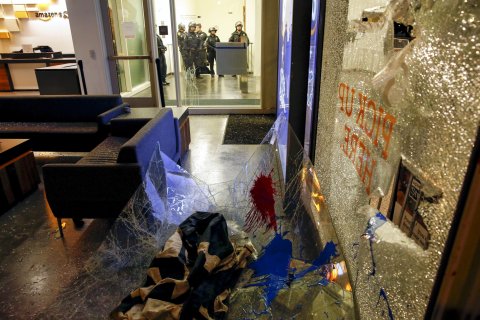
Conservatives have been harsher. Breitbart has called black bloc demonstrators "terrorists...bent on the destruction of the United States of America." Law enforcement officials view them as opportunists who hijack mainstream protests. "We see folks employ the black bloc tactics en masse like that basically anywhere where you have either a conservative cause, such as what we had with the Milo event in Berkeley, or any time you have a guaranteed media presence, such as political conventions, G-8 summits," says Kory Flowers, a police sergeant in Greensboro, North Carolina, and an expert on extremist groups. "Half of these folks don't know the particulars about the cause."
Stephen Zunes, a University of San Francisco professor who has studied social movements, told the San Francisco Chronicle something similar in 2003. "They're basically hoodlums looking for a mass rally to ride the coattails of. They don't have a political agenda. And the worst thing is that they don't have any leaders you can negotiate with."
There is evidence that black blocs hurt nonviolent efforts. A 2015 study published in the journal Mobilization: An International Quarterly found that from 1900 to 2006, nonviolent campaigns around the world were more successful than violent ones. A reason is that fewer people are willing to participate in violent movements, leading to fewer resources. There is also less public sympathy for those who use violence. Previous studies had found success in radical movements, but the researchers dispute the earlier findings.
"The folks that argue that these types of tactics were or are necessary are usually thinking of them in tactical terms," says Erica Chenoweth, a professor at the University of Denver who co-authored the study. "They look to the immediate tactical impacts, like did they shut down a talk." But violent efforts are less effective long term, she continues. "They often cost movements a great deal of sympathy and support." They can also harm movements, because after the violence there tends to be more support for leaders who vow to restore law and order, Chenoweth found (and as Trump has done).
Black bloc participants dispute those findings. One of those people, who requested that Newsweek not print his name because of privacy concerns, says "a diversity of tactics" is necessary. He points to the black bloc in Washington, D.C., on Inauguration Day and the Women's March the following day as an example of how different types of demonstrations should occur. Anderson, of It's Going Down, points to the Indian independence and U.S. civil rights movements as events he believes succeeded because they were largely nonviolent (but also had violent disruptors).
"What we're talking about is mass resistance, mass disruption," he says. "We're not saying, Everybody go get a gun and kill a bunch of people."
'More Than 100 Thugs'
In the aftermath of the UC Berkeley demonstration, some are wondering where the black bloc folks came from and why police arrested so few of them. University of Utah law professor and former federal judge Paul Cassell wrote in The Washington Post, "How is it that after more than 100 thugs organized, well in advance, to invade the campus, and police were alerted to the risk of violence, again well in advance, [almost] no arrests were made the night of the attack?"
Flowers, the expert on extremist groups, says he isn't surprised there were so few arrests. When there are so many people demonstrating, he says, "the priorities change at that point to just protecting lives and property." To arrest a single protester might take multiple officers several minutes, "which is an eternity in the middle of that very, very volatile mayhem." It's unlikely that investigators will be successful identifying any of the demonstrators, he adds, given their disguises.
Anarchists and past black bloc participants say their activities will continue. "As the visibility of fascism has grown," says OLAASM's Toennies, "so too has the visibility of the resistance. People need to know, and I hope that they do know, that there are people like them who are willing to fight back—by any means necessary."




